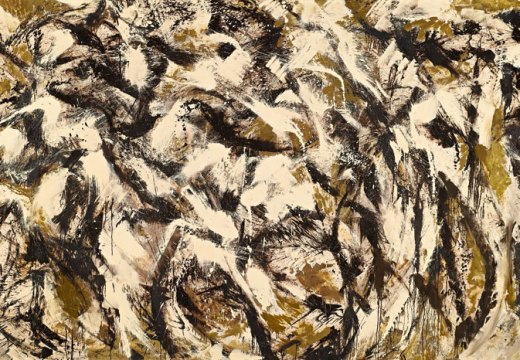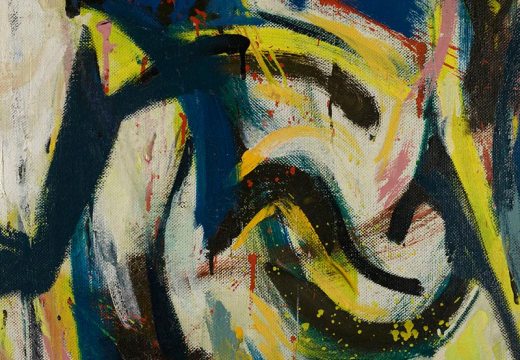‘Why would a famous artist give an interview to a 22-year-old?’ a colleague once challenged me when I spoke about my first meeting with Lee Krasner. At the time, when I first wrote to her, Krasner was in her early sixties, old enough to remind me of my grandmother. I was a second-year doctoral student in art history. For my dissertation project, I wanted to interview Krasner to find out more about the interest in European modernists like Kandinsky and Miró that she shared with her late husband, Jackson Pollock.
I had just interviewed Henry Moore at his home in Much Hadham for my master’s thesis, and Krasner then seemed a lot less famous and therefore less intimidating. A letter came back from her dealer, offering me an appointment on 6 February, 1971, when she agreed to meet with me at the Marlborough Gallery in New York. She allowed me to tape our conversation, which will be published for the first time in the catalogue for the upcoming retrospective at the Barbican in London.

Through Blue (1963), Lee Krasner. Photo: Christopher Stach; © The Pollock-Krasner Foundation
At the time, most critics ignored Krasner’s role as an early innovator of Abstract Expressionism, though she was beginning to attract attention from women, whether art historians, artists, or critics, who were affected by second-wave feminism and were looking for accomplishments by women in the arts.
Since I was eager to find out what books and catalogues were in the couple’s library, Krasner invited me to visit her in East Hampton that summer to have a look for myself. She let me stay in her upstairs guest room, while I went through the books that lined the parlour shelves. The old farmhouse was then hung only with her work, not Pollock’s. I was fascinated to see that she had begun by making traditional figurative work, and I was struck by the power of her abstract paintings. I began to question why she had been left out of recently published histories of Abstract Expressionism. This could have been her motivation in inviting me to visit, since years later I learned that she had already made an inventory of the books I went to see.
Krasner was very kind and respectful of my research, but she could never have imagined that by 1976, I would be working as a curator at the Whitney Museum. Or that I would have the opportunity to collaborate on a show there in 1978, called ‘Abstract Expressionism: The Formative Years’. This exhibition featured the canonical first-generation male painters like Pollock, Mark Rothko, and Willem de Kooning. Though Krasner had always been left out, she became the only woman in our show, which focused on the 1940s. The critics’ response to the inclusion of her work was very positive and she, too, was declared a ‘first generation abstract expressionist’.

Photograph of Lee Krasner in Springs, New York, 1972, by Irving Penn. Photo: © The Irving Penn Foundation.
Krasner’s influence on me was profound. She became my mentor in the art world, with her dry wit, sharp mind, and vast experience, able to explain how things worked. She often invited me to visit her in East Hampton; introduced me to her friends such as Ray Eames, Jimmy Ernst, Bryan Robertson, and Edward Albee; encouraged my writing, and, in the city, often came to my place to join friends for dinner.
My decision to write Krasner’s biography was motivated by the need to correct the historical record. I was shocked by what I read about Krasner in the biography of Pollock by Steven Naifeh and Gregory White Smith. The shock provoked a vivid dream, as I slept in my own East Hampton house, in which Krasner, long dead, appeared to me as a ghost. ‘Why aren’t you writing about me?’ she demanded. ‘Why aren’t you correcting these lies?’ I took her outrage to refer to some of the statements in quotation marks oddly attributed to her in the Pollock biography. I found that they were borrowed from a novel by B.H. Friedman, who told me in a recorded interview that he invented this dialogue and that the fictional couple was not even modelled on Krasner and Pollock. I thought, too, about the meaning of Krasner’s painting, about which she insisted: ‘I think my painting is so autobiographical, if anyone can take the trouble to read it.’
Gail Levin’s Lee Krasner: A Biography is published in the UK by Thames & Hudson this month.
‘Lee Krasner: Living Colour’ is at the Barbican Art Gallery, London, from 30 May–1 September.
From the May 2019 issue of Apollo. Preview and subscribe here.
Unlimited access from just $16 every 3 months
Subscribe to get unlimited and exclusive access to the top art stories, interviews and exhibition reviews.














![Masterpiece [Re]discovery 2022. Photo: Ben Fisher Photography, courtesy of Masterpiece London](http://www.apollo-magazine.com/wp-content/uploads/2022/07/MPL2022_4263.jpg)
It’s time for the government of London to return to its rightful home